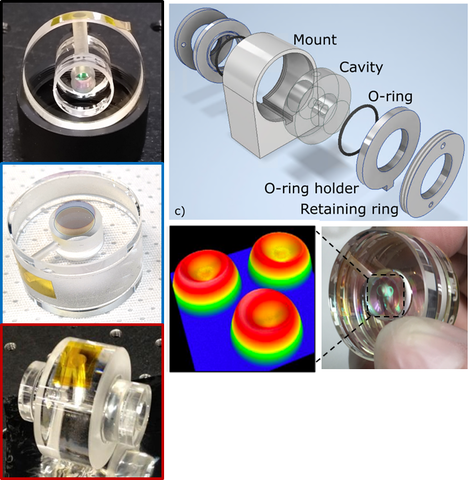Summary
We develop ultrastable lasers with linewidth ~1Hz for compact and deployable platforms.
Description

At the heart of any stable laser is a reference cavity resonator. By locking a laser’s frequency to a reference cavity mode, the laser inherits the resonator’s stability. These stable lasers can then be used in various sensing and spectroscopy applications, including in optical atomic clocks and distributed fiber environmental sensors. Additionally, when used in conjunction with an optical frequency comb, the stability of these lasers can be transferred to the rf, microwave and millimeter-wave domains, aiding in position, navigation and timing applications. In order to realize ultrastable lasers outside the laboratory, we design, build and test extremely compact resonators and laser locking systems.
Attaining sub-1 Hz linewidth with an optical cavity requires careful attention to the fundamental limits of cavity length stability, the thermal and structural properties of cavity materials, and high-precision laser locking techniques. Moreover, these cavities are held in vacuum to remove airpath fluctuations from disturbing the stability. We investigate the optimal materials and methods to generate ultrastable laser frequencies in as compact volume as possible.
Publications
- Davila-Rodriguez, et al, “Compact, thermal-noise-limited reference cavity for ultra-low-noise microwave generation,” Optics Letters 42, p. 1277-1280 (2017)
- J. Guo, et al, “Chip-based laser with 1-hertz integrated linewidth,” Sci. Adv. 8, art. eabp9006 (2022)
- N. Jin, et al, “Micro-fabricated mirrors with finesse exceeding one million,” Optica 9, p. 965 (2022)
- C. McLemore, et al, “Miniaturizing Ultrastable Electromagnetic Oscillators: Sub-10{-14} Frequency Instability from a Centimeter-Scale Fabry-Perot Cavity,” Phys. Rev. Appl. 18 art. 054054 (2022)
- M. Kelleher, et al, “Compact, portable, thermal-noise-limited optical cavity with low acceleration sensitivity,” Optics Express 31, p. 11954 (2023)
Major Accomplishments
- Developed stable optical reference cavities with volume < 10 mL for mobile optical clocks
- Used one of our compact cavity systems for submarine cable monitoring, demonstrating improved sensitivity

